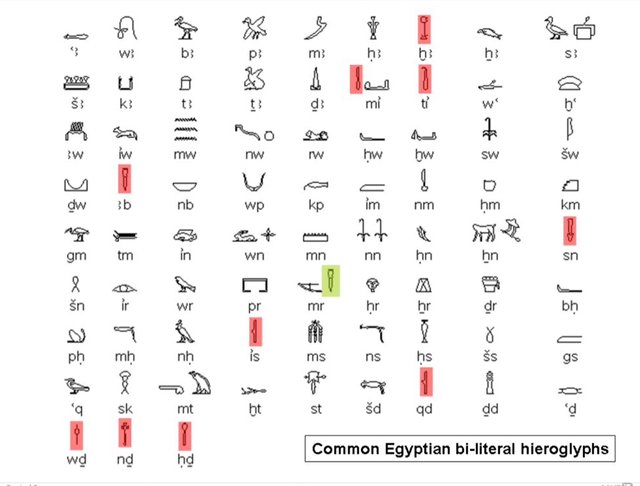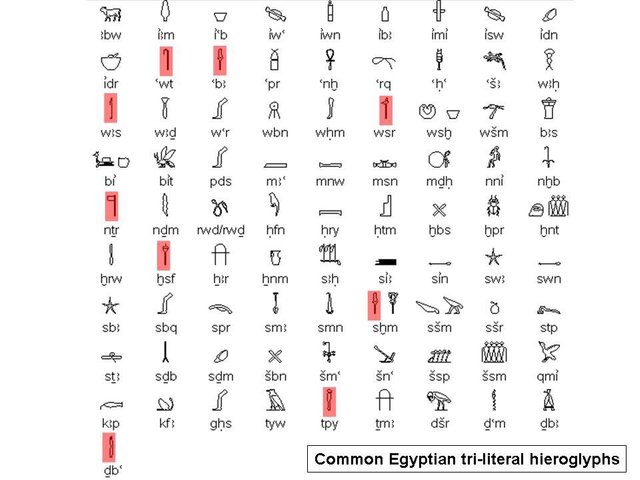🗿 Historyland || How to read hieroglyphs chapter III- Come leggere i geroglifici capitolo III
HOW TO READ HIEROGLHYPS
CHAPTER III
The reading of hieroglyphs
In the previous article we saw how to read the uniliterals, which are probably the most common signs, but certainly, not the only ones of the Egyptian writing system.
The biliterals, as previously explained, are signs composed of a single symbol but they must be read as two letter; usually, excluding the biliterals composed of “consonant + Alef / Waw / Yod / Ayin”, which, as we have seen, they act as "vowels", the other biliterals are formed by “consonant + consonant”. In this case we will find a juxtaposition of two consonants and it’s hard for us to read without inserting, between a consonant and the other, the vowel "e", which as we have seen, not exist in the hieroglyphic writing, but helps us in reading. In this case, signs like pr "home" will be read for “per”.
The list of biliteral signs is quite long, the Allan’ Egyptian Grammar shows some examples, but whenever you meet a sign which is not a uniliteral, it is recommended to search into the Gardiner’s Signs List.

Figure 1
Here are some examples:



Figures 2,3,4
Finally, the last category of these signs; the triliterals. The triliteral is composed of a “consonant + consonant + consonant”; if among these consonants Alef / Waw / Yod / Ayin are present they will be read as vowels, in all other cases the usual "e" will be added between one consonant and the other. The list of triliterals, which are few and less frequent than the other two categories, will show you the most common examples.

Figure 5
Here are some examples:


Figures 6,7
Obviously the world of hieroglyphics is clearly more complex than this little guide has shown you, you will often find signs that should not be read at all and only the context will tell you why, or you will have to read signs that are not written. Or the more adventurous, who will want to try to read directly from the original stems, will notice that some signs have been confused with others by the scribe, or that they are so badly written that you can easily confuse them with other signs.
The world of ancient Egypt is extremely fascinating in its every aspect, the advice I can give to anyone who wants to get closer to this world is to use the sources I mentioned, it takes perseverance and perseverance, often patience will be lacking in you and you will want to abandon everything, but trust me that,as soon as you have captured the secrets of this fascinating language, you will only be proud of yourself.
COME LEGGERE I GEROGLIFICI
CAPITOLO III
La lettura dei geroglifici
Nell’articolo precedente abbiamo visto come si leggono i monolitteri, che sono probabilmente i segni più comuni, ma non di certo gli unici del sistema di scrittura egiziana.
I bilitteri, come precedentemente spiegato, sono segni composti da un solo simbolo ma che valgono come due; solitamente, escludendo i bilitteri composti da consonante + Alef/Waw/Yod/Ayin, che come abbiamo visto fungono da “vocali”, gli altri bilitteri sono formati da consonante + consonante. In questo caso ci troveremo un accostamento di due consonanti per difficilmente potremmo leggere senza inserire, tra una consonante e l’altra, la vocale “e”, che come abbiamo visto, di fatto non esisterebbe nella scrittura geroglifica, ma ci aiuta nella lettura (e secondo gli storici doveva essere presente nel parlato degli antichi egiziani, ma non scritta). In questo caso, segni come pr “casa”, verrà letto per.
La lista dei bilitteri è piuttosto lunga, il manuale di Allen ne riporta alcuni, ma qualora incontriate un segno che non è presente nella tabella dei monolitteri, è sempre bene controllare nella lista dei segni del Gardiner, per accertarsi su cosa realmente sia.

Figura 1
Ecco alcuni esempi:



Figure 2,3,4
Infine ecco l’ultima categoria di segni; i trilitteri. Il trilittero è composto da consonante + consonante + consonante; qualora tra queste consonanti siano presenti Alef/Waw/Yod/Ayin esse si leggeranno come vocali, in tutti gli altri casi verrà aggiunta la solita “e” tra una consonante e l’altra. La lista dei trilitteri, che sono pochi e meno frequenti delle altre due categorie, vi mostrerà gli esempi più ricorrenti.

Figura 5
Ecco alcuni esempi:


Figure 6,7
Ovviamente il mondo dei geroglifici è nettamente più complesso di quanto questa piccola guida vi abbia mostrato, spesso si troveranno segni che non vanno letti e solo il contesto vi dirà il perché, oppure ancora bisognerà leggere segni che non ci sono e lo studio della grammatica vi dirà il motivo della loro mancanza. O i più temerari, che vorranno attentarsi a leggere direttamente dalle steli originali, potranno notare che alcuni segni sono stati confusi con altri dallo scriba, oppure che sono talmente scritti male da essere confusi con altri segni.
Il mondo dell’antico Egitto è estremamente affascinante in ogni suo aspetto, il consiglio che mi sento di dare a chiunque voglia avvicinarsi a questo mondo è di utilizzare le fonti che vi ho citato, ci vuole costanza e perseveranza, spesso la pazienza vi verrà meno e vorrete abbandonare tutto, ma fidatevi che non appena avrete carpito i segreti di questa affascinante lingua, non potrete che essere orgogliosi di voi stessi.
Fonti:
James Peter Allen, Middle Egyptian: an introduction to the language and the culture of Hieroglyphs, Cambridge, University Press, 2010
Nicolas Grimal, A history of Ancient Egypt, Wiley, 1994
Maria Carmela Betrò, Geroglifici, Verona, Mondadori, 1995
Ciampini Emanuele, La lingua dell’Antico Egitto, Milano, Hoepli, 2018
Alan Gardiner, Egyptian Grammar; Being an introduction to the study of Hieroglyphs, Oxford, Griffith Institute, 1957
Foto:
Le immagini non citate, sono realizzate da me.
Figura 1, credits: https://traveltoeat.com/egyptian-hieroglyphs-and-sacred-symbols/
Figura 5, credits: https://traveltoeat.com/egyptian-hieroglyphs-and-sacred-symbols/
This post was selected, voted and shared by the discovery-it curation team in collaboration with the C-Squared Curation Collective. You can use the #Discovery-it tag to make your posts easy to find in the eyes of the curator. We also encourage you to vote @c-squared as a witness to support this project.
This post has been voted on by the SteemSTEM curation team and voting trail. It is elligible for support from @curie.
If you appreciate the work we are doing, then consider supporting our witness stem.witness. Additional witness support to the curie witness would be appreciated as well.
For additional information please join us on the SteemSTEM discord and to get to know the rest of the community!
Please consider setting @steemstem as a beneficiary to your post to get a stronger support.
Please consider using the steemstem.io app to get a stronger support.
Congratulations @maryincryptoland! You have completed the following achievement on the Steem blockchain and have been rewarded with new badge(s) :
You can view your badges on your Steem Board and compare to others on the Steem Ranking
If you no longer want to receive notifications, reply to this comment with the word
STOPVote for @Steemitboard as a witness to get one more award and increased upvotes!